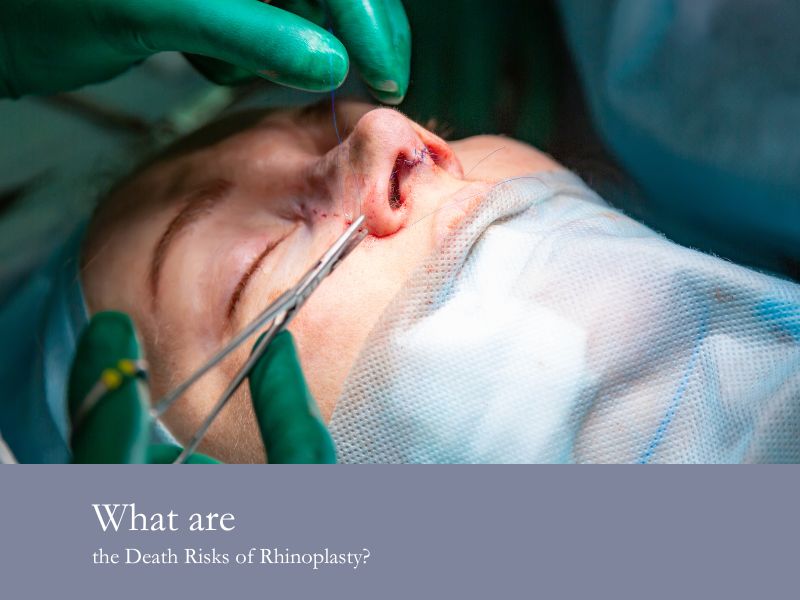If you’re concerned about rhinoplasty risks, you’re in the right place. Rhinoplasty is an invasive type of cosmetic surgery that creates brilliant results, but requires you to measure risk and reward.
What are the risks and complications associated with rhinoplasty, like complications during surgery or uncomfortable symptoms during the recovery period? If you’re currently weighing the pros and cons of getting nose surgery, we’ll answer common questions to help you make an informed decision.
Table of Contents
What are the Two Main Types of Rhinoplasty?
Also known as a ‘nose job’, rhinoplasty surgery is a careful cosmetic procedure that reshapes your nose. The two main types are open rhinoplasty and closed rhinoplasty, earning their names due to their unique methods of addressing cartilage and bone.
Open rhinoplasty provides the most dramatic changes, since it involves completely separating a patient’s skin from their nose and cartilage. Closed rhinoplasty is less invasive, involving small and delicate cuts throughout the nose to subtly change its appearance.
It’s important to note that these two types of rhinoplasty have additional classifications, such as:
- Tip plasty: This less invasive type of closed rhinoplasty involves slightly changing the nasal tip with local anesthesia.
- Functional rhinoplasty: Patients turn to this facial plastic surgery after an injury to restore their appearance and/or nasal function.
- Revision rhinoplasty: If there are any complications with your plastic surgery treatment, your medical professional can make revisions for further shaping.
What are the Most Common Risks of Rhinoplasty?
What are the potential risks and complications associated with rhinoplasty? Your risk factors will depend on everything from your medical history to the type of rhinoplasty procedures you need.
Nose reshaping surgery can help a person feel more comfortable in their own skin, breathe more easily, or even reduce sleep apnea symptoms. However, some patients may not be comfortable with the possibility of an asymmetrical result.
An experienced rhinoplasty surgeon will help you understand these common risks and answer any questions you have so you’re completely comfortable with your decision.
1. You Might Get an Unsatisfactory Nasal Appearance
One of the biggest concerns patients have with rhinoplasty complications is not enjoying the final result. You may worry your nose looks crooked, too big, or too small compared to what you hoped for.
As such, there’s always a possibility you may need a second procedure to readjust the nasal bones. Revisional rhinoplasty surgery will correct any mistakes, though that also means you need to go through another recovery period.
2. All Surgery Comes With a Possibility of Infection
Since surgical procedures involve cutting the skin and cartilage, there’s always a possibility of an infection during the recovery phase. Common signs of infection or poor wound healing include:
- Persistent redness and soreness even after your surgeon’s estimated recovery time
- Burning, itching, or oozing
- Nerve damage that causes stinging or twinging sensations
3. Some People May Experience Difficulty Breathing
What are the risks of rhinoplasty for how you breathe? While it’s normal to experience slightly different breathing for the first few weeks after rhinoplasty, persistent breathing problems are a risk. These issues usually happen due to pinched nasal valves or nasal congestion during the recovery period.
4. You May Notice a Change in Your Skin Sensation
While we touched on nerve damage in the previous section, there are additional risks, such as numbness or hypersensitivity. Some patients may report unusual sensitivity to extreme temperatures or tenderness to the touch.
While these issues generally resolve themselves after the recovery period, they can persist due to potential tissue damage. It’s important to maintain consistent communication with your surgeon during the recovery period to get to the root of these subtle side effects.
5. You May Experience a Nasal Septal Perforation
This term refers to damage to your nasal septum, manifesting as a hole in the cartilage between your nostrils (which you can see when looking into one nostril from below). Depending on the size of this hole, you can experience mild discomfort or multiple lingering health problems, such as:
- Difficulty breathing
- Strange nasal pressure
- Crusting and flaking
- Nosebleeds
- Constant runny nose
6. Serious Issues Can Include Skin Necrosis
Sometimes a rhinoplasty surgery can irreparably damage certain parts of the nose by cutting off blood flow. When your skin tissue doesn’t receive enough blood, you’ll start to lose cells and experience a condition called skin necrosis.
Dead tissue cells can cause rot, leading to a potentially serious infection if the rot enters your bloodstream.
What are the Death Risks of Rhinoplasty?
While not a comfortable subject to discuss, it’s essential to understand the full risks of functional or cosmetic rhinoplasty before proceeding. Overall, the risk of death from rhinoplasty — whether during surgery or post operative — is extremely low.
The most common risks that could lead to death are a severe allergic reaction to anesthesia, toxic shock caused by a serious infection, or breaking bones that could injure the brain.
Frequently Asked Questions: Rhinoplasty Risks
Rhinoplasty surgery is a complex procedure, so it’s understandable to still have concerns about how it works. We’re dedicated to making sure you feel ready for your procedure, so we’ll answer your questions here.
Is Rhinoplasty 100% Safe?
No invasive surgery will be completely free of the risk of potential complications. However, rhinoplasty surgery is extremely low risk when you work with an experienced surgeon.
Are There Any Long-Term Side Effects of Rhinoplasty?
Most rhinoplasty surgeries have no long-term side effects. Occasionally, some patients may experience persistent numbness or sensitivity on certain parts of the nose or need revision surgery if they’re not satisfied with the results.
What Happens 10 Years After Rhinoplasty?
Rhinoplasty usually looks the same after a decade since the skin around the nose is very thin and doesn’t wrinkle or sag as much as other parts of the face. However, you may occasionally notice subtle changes in elasticity due to reduced collagen production.
What is the best rhinoplasty for a wide nose?
Ethnic rhinoplasty augmentation often uses ear or rib cartilage grafts to build nasal structure. This aesthetic procedure helps reshape a wide nose, making it longer and more refined, especially in patients of African or Asian descent.
Contact Us for Your Rhinoplasty Surgery Consultation Today
An experienced surgeon doesn’t shy away from the risks and complications that come with surgery. You deserve a safe and transparent environment to explore the potential benefits of rhinoplasty procedures.
Dr. Sanam Zahedi provides thorough one-on-one consultations at Zahedi Plastic Surgery with each patient, exploring all possible risk factors before getting started. We’re committed to helping you feel completely confident in your decision and are ready to answer any questions or concerns you have.
Reach out to us today to see if a rhinoplasty surgery is right for you.




